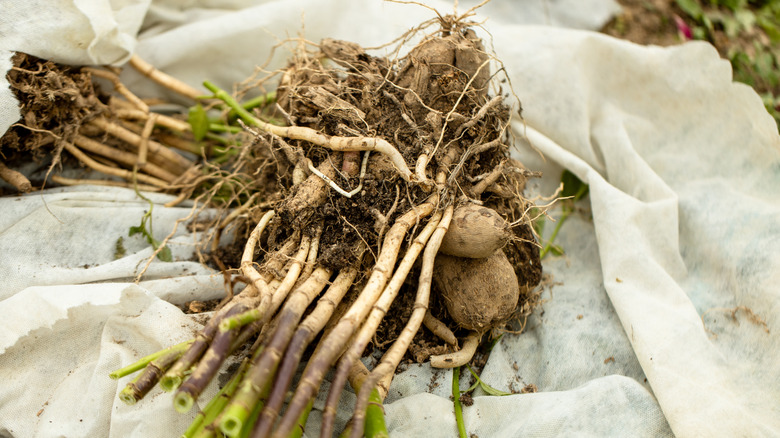The Easy Precaution To Take That Keeps Dahlia Plant Tubers Alive All Winter
Caring for dahlias doesn't have to be difficult. You may have even thought you already had a handle on everything you need to know before planting. But now you want to overwinter your dahlias, and you're greeted with endless advice about what to do. The truth is, dahlias aren't picky, so there are plenty of ways to keep your dahlia plant tubers alive all winter. Aside from protecting your dahlia tubers from frost, the biggest reason to dig them up and store them is to prevent rotting. Unfortunately, there are plenty of winter storage mistakes that could hurt your chances of success in the spring, and moisture control is one of them. While things like peat moss and compost will help keep the tubers warm, they may not be the best option for keeping them dry. Burlap, on the other hand, is perfect for Dahlias.
Of course, it is important to be aware of how your hardiness zone may impact your tubers, because some zones need a bit more work than others. For example, if you are in zones 2 to 6, you will probably need to dig up the tubers and protect them from freezing. Some people will tell you that you should place them in a container with moss to keep them warm through the winter, but that can be more of a hassle than it's worth. Burlap is an easier precaution you can take to keep dahlia plant tubers alive all winter.
How to wrap your dahlia plant tubers in burlap to help them survive winter
Start by carefully digging up the dahlia tubers and removing them from the ground. You can take this time to divide them if you wish. Before you can wrap the tubers, you will want to take the time to clean them and examine them for any potential damage, rot, or common dahlia diseases. You can rinse the tubers in water to remove dirt. Experts like Alan Fisher, a committee chair at Dahlia.org, recommend rinsing your tools with a bleach solution. A little goes a long way; you only need a mixture of one part bleach and 10 parts water. You can also dip the tubers in a bleach solution with 1 teaspoon of bleach per gallon of water to prevent fungus. With a clean station and tools, divide tubers as necessary (usually this is done when eyes are visible).
Now, you can get to the actual storage preparation, and this step doesn't take much effort. You can think of this part as tucking them in for the winter. Cut burlap fabric large enough to completely cover a single tuber. Wrap each tuber in its own burlap square and place them securely in a crate. If you really want to get crafty, you can sew the edges of the fabric to make tuber pouches or bags for a more snug fit. Allow them to dry completely, then store the crate in a cool, dry area for the winter. Tubers survive best in temperatures between 40 and 45 degrees Fahrenheit. Check the tubers once per month for rotting, disease, or damage.

